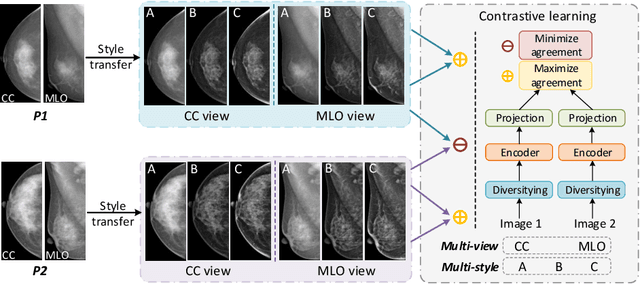Yuezhi Yang
ToothInpaintor: Tooth Inpainting from Partial 3D Dental Model and 2D Panoramic Image
Nov 25, 2022Abstract:In orthodontic treatment, a full tooth model consisting of both the crown and root is indispensable in making the treatment plan. However, acquiring tooth root information to obtain the full tooth model from CBCT images is sometimes restricted due to the massive radiation of CBCT scanning. Thus, reconstructing the full tooth shape from the ready-to-use input, e.g., the partial intra-oral scan and the 2D panoramic image, is an applicable and valuable solution. In this paper, we propose a neural network, called ToothInpaintor, that takes as input a partial 3D dental model and a 2D panoramic image and reconstructs the full tooth model with high-quality root(s). Technically, we utilize the implicit representation for both the 3D and 2D inputs, and learn a latent space of the full tooth shapes. At test time, given an input, we successfully project it to the learned latent space via neural optimization to obtain the full tooth model conditioned on the input. To help find the robust projection, a novel adversarial learning module is exploited in our pipeline. We extensively evaluate our method on a dataset collected from real-world clinics. The evaluation, comparison, and comprehensive ablation studies demonstrate that our approach produces accurate complete tooth models robustly and outperforms the state-of-the-art methods.
Discovering Design Concepts for CAD Sketches
Oct 26, 2022Abstract:Sketch design concepts are recurring patterns found in parametric CAD sketches. Though rarely explicitly formalized by the CAD designers, these concepts are implicitly used in design for modularity and regularity. In this paper, we propose a learning based approach that discovers the modular concepts by induction over raw sketches. We propose the dual implicit-explicit representation of concept structures that allows implicit detection and explicit generation, and the separation of structure generation and parameter instantiation for parameterized concept generation, to learn modular concepts by end-to-end training. We demonstrate the design concept learning on a large scale CAD sketch dataset and show its applications for design intent interpretation and auto-completion.
Domain Generalization for Mammography Detection via Multi-style and Multi-view Contrastive Learning
Nov 21, 2021



Abstract:Lesion detection is a fundamental problem in the computer-aided diagnosis scheme for mammography. The advance of deep learning techniques have made a remarkable progress for this task, provided that the training data are large and sufficiently diverse in terms of image style and quality. In particular, the diversity of image style may be majorly attributed to the vendor factor. However, the collection of mammograms from vendors as many as possible is very expensive and sometimes impractical for laboratory-scale studies. Accordingly, to further augment the generalization capability of deep learning model to various vendors with limited resources, a new contrastive learning scheme is developed. Specifically, the backbone network is firstly trained with a multi-style and multi-view unsupervised self-learning scheme for the embedding of invariant features to various vendor-styles. Afterward, the backbone network is then recalibrated to the downstream task of lesion detection with the specific supervised learning. The proposed method is evaluated with mammograms from four vendors and one unseen public dataset. The experimental results suggest that our approach can effectively improve detection performance on both seen and unseen domains, and outperforms many state-of-the-art (SOTA) generalization methods.
* Pages 98-108
 Add to Chrome
Add to Chrome Add to Firefox
Add to Firefox Add to Edge
Add to Edge